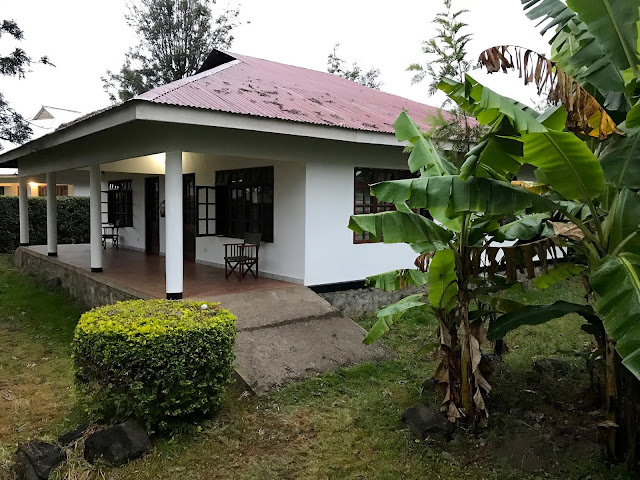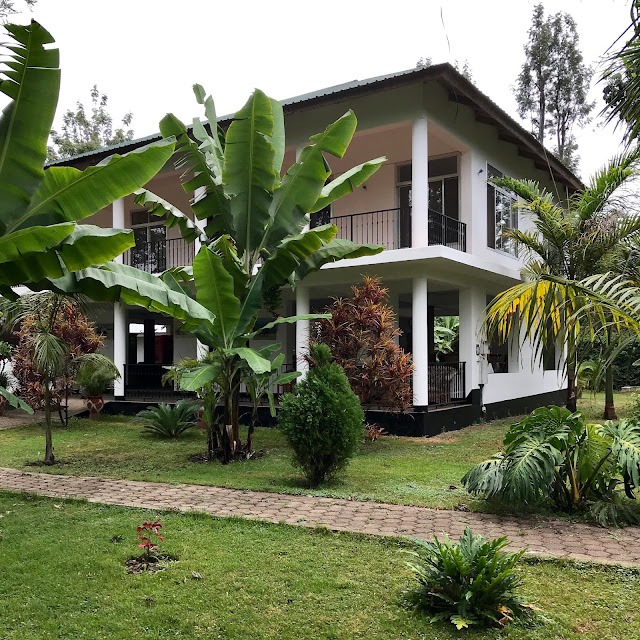OMG! AM I REALLY HERE IN AFRICA?
Doug and I have been planning this trip for eight months. It is our first OAT trip because we had to cancel another OAT trip to China and Mongolia for September 2017 after Doug's surgery and subsequent stroke. However, last February we took our first ocean cruise post-stroke to see how Doug's recovery was progressing, and he passed. So upon our return, he booked the Serengeti Tented Safari along with both the pre-trip and post-trip extensions for October of this year. And then we began the long wait.
We broke up our long trans-continental and trans-Atlantic flights with a 3-day stopover in Amsterdam, and we are glad we did. But now after an 8-hour flight from Schiphol Airport in Amsterdam, we've landed in Kilimanjaro National Airport in Tanzania, Africa and we're excited.
As per instructions, we were greeted outside customs by Lenny, our Trip Leader, and Salum, our other driver/guide for the pre-trip. We recognized the other OAT travelers by their tell-tale khaki canvas duffles and gathered together in the warm night air of Tanzania to begin our adventure. Of the 11 people on the pre-trip, all were novices to this part of Africa except one who was repeating this trip for the fourth time. Wow! It must be THAT good to repeat it four times, I thought. So bring it on!
After a 45-minute drive (on the left side of the road as they are wonky drivers like the English-LOL), we arrived at our first lodge--The House of West Kili. It is located, as you may have guessed, on the western slopes of Mt. Kilimanjaro in the small village of Lawate.
It was dark when we arrived and we were tired as we were led to our cottages, but I remarked to myself when were given our key how appropriate it was that the couple from Walla Walla was staying in the room named Swala. It had a nice ring to it.
(Swala, by the way, means antelope in Swahili.)
Our room was just as I had imagined it to be. A four-poster bed with mosquito netting draped all around.
And the bathroom was enormous. But this was the beginning of remembering to brush our teeth with bottled water, a resource OAT provided for our entire 21-day trip.
Our first meal in Tanzania was back at the lodge that was set with candlelight and Maasai beaded neck rings as placemats. What a memorable welcome!
Our first African meal was vegetable soup and bread which was nothing like the Cambell's or Progresso soups I serve back home.
Upon waking in the morning, I could see where we were. Each cottage has two separate guest rooms with a common veranda, and there are a total of ten cottages. The owner, Abraham, used to be an OAT Trip Leader who, during his off-time, built this lodge to serve as a stopping point between the airport and Mt. Kilimanjaro for trips like OAT and others. Now he runs the lodge and restaurant full time.
This is the main building which holds the dining room/restaurant and a conference center.
And this is Abraham who took a liking to Doug since they are both tall. Brothers from a different mother, no doubt.
And this is Lenny, our fearless and intrepid Trip Leader. I wonder what he has in store for us.
Our first African breakfast included fruits, vegetables and pancakes that were both colorful and tasty.
After breakfast, Abraham gave us a geography and history lesson of the region. A nice feature of OAT is that the Trip Leader utilizes local experts to give lectures and briefings which supplement his own wealth of information.
With OAT, it's all about Learning and Discovery, and we were about to find out firsthand just what that meant.
GETTING LOCAL
Home Visit
Home Visit
Our first of what turned out to be several home visits was not on the official itinerary of our first day in the hills of Kilimanjaro. In fact, nothing we did that first morning was in our itinerary, but this home visit set a high bar for a wealth of Learning and Discovery to come. I have to admit, however, I was not prepared to face the stark reality of the conditions in which many people live in Tanzania.
After breakfast, Abraham took us across the street from the West Kili Lodge to meet the family who lives there. This is his neighborhood because besides owning the lodge, he lives next door with his own family. We were accompanied by another local guide who knows the family. It consists of a grandmother, her daughter, and her three grandchildren. They live in a compound of several small brick and mud huts along with their cow, goats and chickens. They have a separate fenced off area for their latrine only a short distance from the huts.
As an aside, all of these photos were taken with permission of the family. In fact, whenever we visited a family or a group of people, the guides had asked permission for us to take photographs.
 |
| Here we are meeting the grandmother who is 75-80 years old. |
This is the grandmother's cooking hut made of bricks and mud. The roof is covered with black plastic tarps and what appears to be random, loose sheets of rusty, corrugated metal.
This is the younger grandson with the family cow which lives in this shed only feet from the family living hut.
This is his older sister who was only too happy to pose for a photo as long as I showed her the results.
It was immediately obvious that she and her brothers have seen enough cell phones to know how to scroll through the photos.
The sister and her older brother.
Initially, the older brother was more reluctant to get his picture taken but soon decided to join in the fun. Note the hen and baby chicks in the lower left.
With the sun beating down on the black tarps, they appear to weather and fade to create this lovely warm glow from inside the cooking hut. The only other light is from the doorway and a small window along one side.
That is except for this re-cycled and re-purposed can that's made into a kerosene lantern.
Here is the grandmother who seemed eager to show us her kitchen and all the utensils she uses. As you can see, she sits on a low wooden stool to cook at the wood and charcoal fire.
There was only room for 3-4 of us to stand in the hut to watch her demonstration.
With a telling grin on her face, the grandmother seems pleased to show us how she can whisk the contents of the pot simply by rolling the stick back and forth between her hands.
Chopping a supply of firewood is a daily chore.
A mortar and pestle is a standard kitchen tool used to crush grains, herbs, and whatever else needs crushing.
A forked tree branch works great for moving pots on and off the fire.
This is the only window in the small cooking hut.
This is the outdoor kitchen located next to the daughter's hut.
Pots and pans dry on top of this goat shed.
With no glass in the window, cardboard boxes serve to keep out the wind, blowing dust, flying birds, and whatever else.
The nearby bushes serve to hold drying striped socks which are part of the children's school uniform.
Other pieces of the uniform hang on the clothes line. Public school uniforms are the same colors as the Tanzanian flag--blue, green, black and yellow.
Despite the spare living conditions, these potted ornamental plants suggest that people still have a need to grow plants just for their beauty.
Lace tennies atop the roof--a still life
What hopes and dreams lie in the future of this young man?
A red amaryllis was the last thing I saw as we walked along the path leaving the house.
REFLECTION: To say this home visit was sobering is an understatement. I know I have lived a privileged life being a white, educated, professional albeit retired, middle class, American woman. In fact, that was one of my concerns in traveling to Tanzania with a group of similarly privileged Americans. How do we come across to others who, as I just witnessed, have so little?
Part of that gap was bridged by Abraham and our Trip Leader Lenny, who had clearly pre-arranged this visit, as spontaneous as it seemed to us. That they could speak Swahili with the family helped us communicate by asking and answering our questions.
But it was the smiles that bridged the remaining gap. A smile knows no language. The quiet grin on the face of the grandmother suggests how proud she was to show us her range of culinary tools. And the smiles on bright faces of the children suggest a contentment with their life because this is all they know.
In the next blog, take a ride in an authentic Tuk-Tuk and drink banana beer.
Part of that gap was bridged by Abraham and our Trip Leader Lenny, who had clearly pre-arranged this visit, as spontaneous as it seemed to us. That they could speak Swahili with the family helped us communicate by asking and answering our questions.
But it was the smiles that bridged the remaining gap. A smile knows no language. The quiet grin on the face of the grandmother suggests how proud she was to show us her range of culinary tools. And the smiles on bright faces of the children suggest a contentment with their life because this is all they know.
In the next blog, take a ride in an authentic Tuk-Tuk and drink banana beer.










































No comments:
Post a Comment